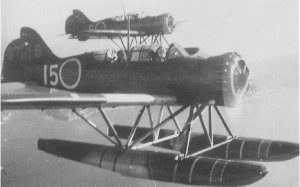![]() The Pacific War Online Encyclopedia
The Pacific War Online Encyclopedia
|
| Previous: E13A "Jake", Japanese Reconnaissance Floatplane | Table of Contents | Next: E16A "Paul", Japanese Reconnaissance |

Imperial Japanese
Navy. Via Wikipedia
Commons
Yokosuka E14Y1 "Glen"
| Crew | 2 in tandem cockpit |
| Dimensions | 36'2" by 28'1" by 12'6" 11m by 8.54m by 3.8m |
| Wing area | 205 square feet 19 square meters |
| Weight | 2469-3527 lbs 1119-1600 kg |
| Maximum
speed |
153 mph at sea level 246 km/h at sea level |
| Cruising speed | 104 mph at 3280 feet 167km/h at 1000 meters |
| Climb rate | 16 feet per second 4.9 meters per second |
| Ceiling | 17,780 feet 5420 meters |
| Power plant | One 340 hp (254 kW) Hitachi Tempu 12 nine-cylinder air-cooled radial engine driving a two-bladed wooden propeller. |
| Armament | One flexible 7.7mm Type 92 machine gun in the rear cockpit |
| External stores | 60kg (132lbs) bombs |
| Range | 548 miles 882 km |
| Production | A total of 126 aircraft, mostly by K.K. Watanabe Tekkosho (1941-1943) |
The Glen was designed specifically to be a submarine-borne reconnaissance
seaplane, with floats and wings
that were easily detached for stowage.
It was the only type of manned aircraft to ever drop bombs on the American mainland, when a Glen
from I-25
dropped four phosphorus bombs
along the Oregon coast in an attempt to
set the forests on fire. The
aircraft also performed the Japanese
damage assessment following
the Pearl
Harbor strike, and performed similar reconnaissance duties over
other Allied ports until
increased use of radar made such
sorties impossible.
The prototype was completed in 1939 and went into
production in 1941 after successfully winning its design competition
against the Watanabe E14W. The Pearl Harbor reconnaissance mission was
its operational debut.
The aircraft was handicapped by its inability to
operate in any kind of rough seas. It also had miserable performance,
making its early penetrations of Allied air space all the more
remarkable.
References
The Pacific War Online Encyclopedia © 2007-2010 by Kent G. Budge. Index